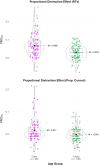Aging Increases Cross-Modal Distraction by Unexpected Sounds: Controlling for Response Speed
- PMID: 34603010
- PMCID: PMC8480473
- DOI: 10.3389/fnagi.2021.733388
Aging Increases Cross-Modal Distraction by Unexpected Sounds: Controlling for Response Speed
Abstract
It is well-established that task-irrelevant sounds deviating from an otherwise predictable auditory sequence capture attention and disrupt ongoing performance by delaying responses in the ongoing task. In visual tasks, larger distraction by unexpected sounds (deviance distraction) has been reported in older than in young adults. However, past studies based this conclusion on the comparisons of absolute response times (RT) and did not control for the general slowing typically observed in older adults. Hence, it remains unclear whether this difference in deviance distraction between the two age groups reflects a genuine effect of aging or a proportional effect of similar size in both groups. We addressed this issue by using a proportional measure of distraction (PMD) to reanalyze the data from four past studies and used Bayesian estimation to generate credible estimates of the age-related difference in deviance distraction and its effect size. The results were unambiguous: older adults exhibited greater deviance distraction than young adults when controlling for baseline response speed (in each individual study and in the combined data set). Bayesian estimation revealed a proportional lengthening of RT by unexpected sounds that was about twice as large in older than in young adults (corresponding to a large statistical effect size). A similar analysis was carried out on the proportion of correct responses (PC) and produced converging results. Finally, an additional Bayesian analysis comparing data from cross-modal and uni-modal studies confirmed the selective effect of aging on distraction in the first and not the second. Overall, our study shows that older adults performing a visual categorization task do exhibit greater distraction by unexpected sounds than young adults and that this effect is not explicable by age-related general slowing.
Keywords: aging; attention capture; auditory distraction; cross-modal attention; deviance distraction; oddball.
Copyright © 2021 Leiva, Andrés and Parmentier.
Conflict of interest statement
The authors declare that the research was conducted in the absence of any commercial or financial relationships that could be construed as a potential conflict of interest.
Figures
Similar articles
-
Aging increases distraction by auditory oddballs in visual, but not auditory tasks.Psychol Res. 2015 May;79(3):401-10. doi: 10.1007/s00426-014-0573-5. Epub 2014 May 23. Psychol Res. 2015. PMID: 24852497
-
When aging does not increase distraction: Evidence from pure auditory and visual oddball tasks.J Exp Psychol Hum Percept Perform. 2015 Dec;41(6):1612-22. doi: 10.1037/xhp0000112. Epub 2015 Jul 27. J Exp Psychol Hum Percept Perform. 2015. PMID: 26214503
-
The role of age, working memory, and response inhibition in deviance distraction: A cross-sectional study.Dev Psychol. 2016 Sep;52(9):1381-93. doi: 10.1037/dev0000163. Epub 2016 Aug 8. Dev Psychol. 2016. PMID: 27505694
-
Cross-modal distraction by deviance: functional similarities between the auditory and tactile modalities.Exp Psychol. 2012;59(6):355-63. doi: 10.1027/1618-3169/a000164. Exp Psychol. 2012. PMID: 22750743
-
Food words distract the hungry: Evidence of involuntary semantic processing of task-irrelevant but biologically-relevant unexpected auditory words.PLoS One. 2018 Jan 4;13(1):e0190644. doi: 10.1371/journal.pone.0190644. eCollection 2018. PLoS One. 2018. PMID: 29300763 Free PMC article.
Cited by
-
Affective distraction by emotional arousal during visual attention: a comparative study with young and older adults.Cogn Process. 2025 Aug 12. doi: 10.1007/s10339-025-01294-5. Online ahead of print. Cogn Process. 2025. PMID: 40794349 No abstract available.
References
LinkOut - more resources
Full Text Sources
Miscellaneous


